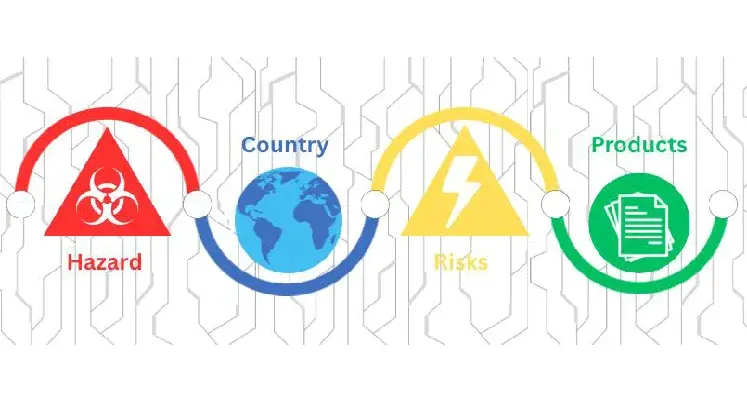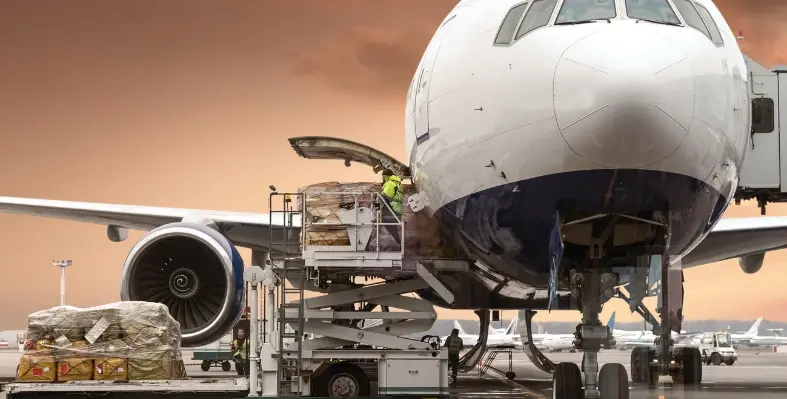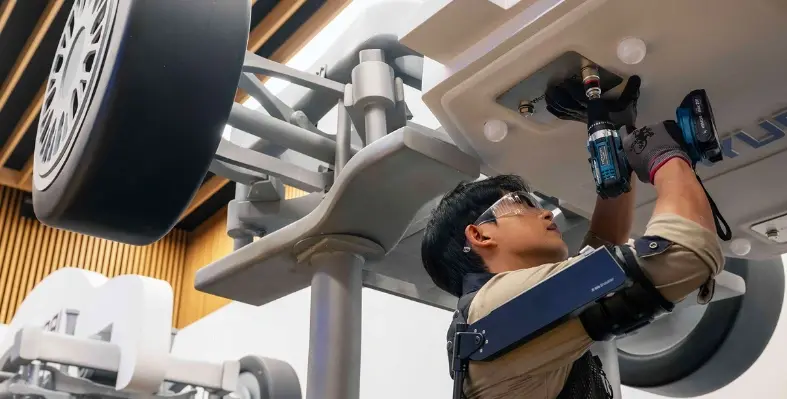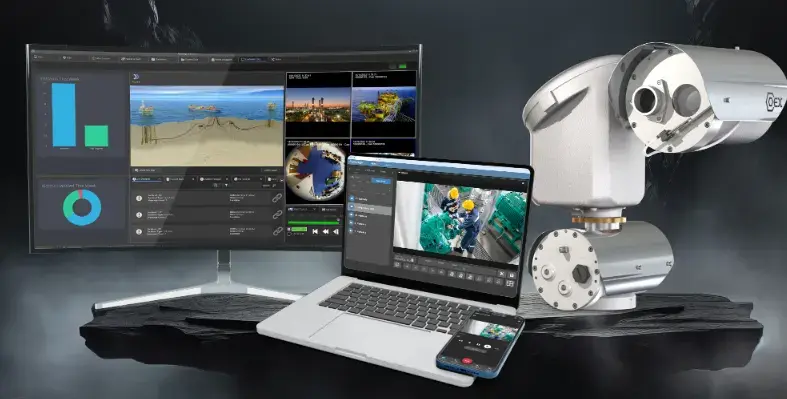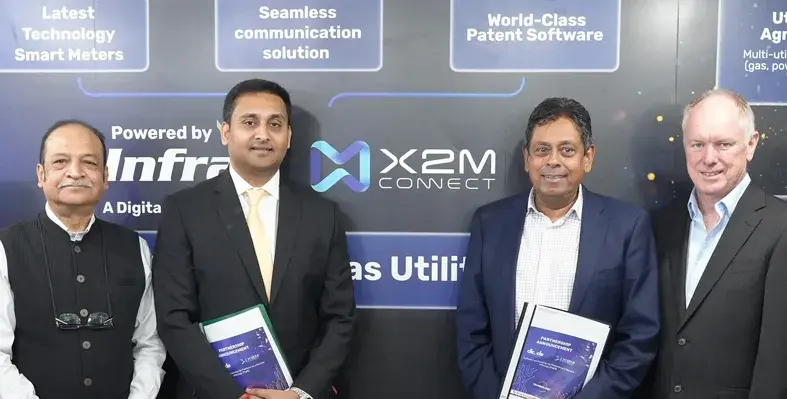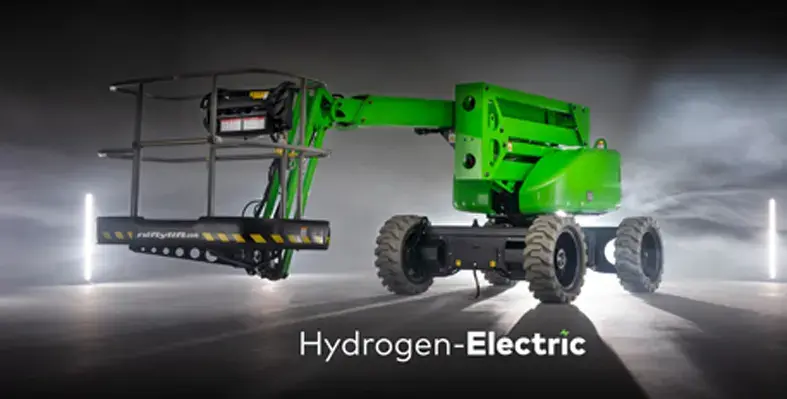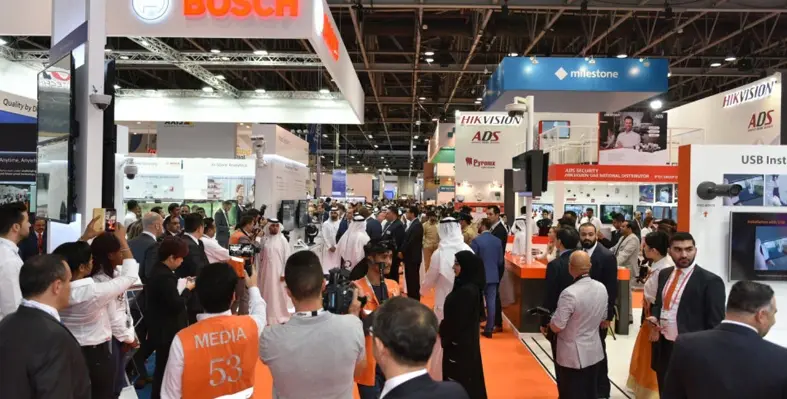Technology
Technology
- Details
- Louise Waters
- Technology
- Topic: Technology
- Date: 30 May 2025
- Year: 2025
With more than two million Muslims set to descend on Mecca for the annual hajj pilgrimage, Aramco Digital, in collaboration with the Communications, Space and Technology Commission (CST) has carried out a successful trial in crowd management using AI and specialised communications services in the Holy Sites
The trial was carried out in partnership with the Supreme Authority for Industrial Security, the Saudi Water Authority (SWA), and Saudi Arabia Railways (SAR).
The initial operational deployment of the 450 MHz mission-critical network combines AI-powered crowd management, secure communications and integrated digital infrastructure to enhance field operations and ensure a safer and more connected pilgrimage experience.
It will enable seamless, real-time voice and video communications, ensuring the quality and continuity of services provided to pilgrims while offering secure, high-efficiency connectivity with instant response, unaffected by network congestion.
The initiative reflects the network’s readiness to operate in complex, high-density environments – enabling in-depth performance analysis, real-time insight generation and faster decision-making across operations.
The system will provide real-time crowd and vehicle analytics, with instant detection of crowd density, vehicle types and movement patterns. Edge AI enables immediate recognition of safety incidents and traffic anomalies, enhancing control, reducing latency and eliminating dependence on the crowd.
By leveraging AI-powered crowd management, secure communications and integrated digital infrastructure in a complex, high density environment, the system sets a new standard in safety and efficiency and is set to enhance co-ordination for future Hajj operations.
The trials were conducted using specialised wireless communication network operating in the 450 MHz band, which was licensed to Aramco Digital in October 2024.
Eid AlHarbi, president of connectivity at Aramco Digital, commented, “The initial operational development of the mission-critical network during this year’s Hajj represented a pivotal milestone in demonstrating the network’s performance and resilience within one of the most operationally intensive and high-density environments. This step supports the broader national rollout, positioning the network as a key enabler for industrial sectors to accelerate their digital transformation in full alignment with Saudi Vision 2030.”
- Details
- Louise Waters
- Technology
- Topic: Technology
- Date: 19 May 2025
- Year: 2025
The World Health Organization (WHO) Regional Office for the Eastern Mediterranean has launched an All-Hazard Information Management (AIM) Toolkit, which leverages generative artificial intelligence to reduce the time needed to produce critical response documents from weeks to minutes
The AIM Toolkit equips WHO and health authorities with a rapid, reliable and context-sensitive mechanism to guide emergency decision-making, as the region wrestles with multiple emergencies from disease outbreaks to climate-related shocks and conflict.
The Toolkit enables WHO teams to access and organise technical guidance from WHO and partners; structure response frameworks around clearly defined objectives, actions and indicators; automatically tailor essential documents, including risk assessments and response plans, to specific countries and hazards; and identify potential gaps and ensure technical completeness under time constraints.
It thereby enables experts to focus on high-level analysis and strategic decision-making rather than document production, significantly accelerating early response while preserving adherence to WHO standards.
“In a context of shrinking resources, we are constantly asked to do better with less and still meet rising needs across the Region,” said Dr Ahmed Zouiten, regional emergency director ad-interim. “The AIM Toolkit is not just about speed. It’s a game-changer in how we use knowledge, turning global guidance into real-time, country-specific action, powered by AI. This is how we help countries respond faster, smarter and with greater precision in times when it matters most.”
It is anticipated that in the future the AIM Toolkit will be developed to incorporate real-time health data, support the development of workflows and standard operating procedures and further strengthen regional readiness and resilience.
The WHO sees the AIM toolkit as a step forward in ensuring that no community is left behind in times of crisis, underlining a shared commitment to protect the most vulnerable, strengthen health systems and ensure that every response is grounded in equity, evidence and solidarity.
- Details
- Sania Aziz
- Technology
- Topic: Technology
- Date: 27 January, 2025
- Year: 2025
Florian Combacau, portfolio alignment director at Axis Communications, speakes to Health, Safety and Environment Review about the company’s latest offerings and industry analysis.
Speaking about artificial intelligence and how it can transform the security industry, Combacau said, “Deep learning technologies are the bread and butter of most analytics solutions within the security sector, while newer generative AI technologies are rapidly maturing. There is still a lot of hype in certain areas but real applications of generative AI in the security sector are becoming available. Each step of evolution brings with it a new set of opportunities, but also ethical, legal, and corporate considerations."
More importantly, Combacau is confident that there will be improvement from an ethical perspective.
“Eventually this will enable generative models to be, at least partly, run on cameras with high-quality results. At the same time the models are improving in quality with regards to ethical aspects, bias, hallucinations, and the risk of making the wrong decisions.
Combacau also added that Axis body-worn cameras are designed for versatility, durability, and ease of use, making them ideal for police forces and critical sectors. Key features include seamless integration via an open API, live video streaming, and military-grade hardware for demanding environments. With advanced cybersecurity measures, cost-effective end-to-end solutions, and user-friendly functionality, Axis cameras ensure high-quality performance and secure data management without proprietary lock-ins or recurring fees.
2025 trends
When speaking of key trends and growth opportunities for the security industry in 2025, Combacau said, “Some of the trends we can expect are really just evolutions of those we’ve seen in previous years. An obvious one is the continued interest in how AI will be applied in our sector, and we’ve highlighted some of the new considerations that will need to be addressed moving forwards.
“Regulation is another area of focus for the industry this year. National and regional legislators will once again try to keep pace with technological innovation. AI, cybersecurity, privacy, the need for resilience in critical entities; all these (and more) will be the focus of proposed and new regulation. We haven’t highlighted this as a specific trend, but it’s no less a priority and something every organisation will need to respond to.
“Advances in analytics and AI mean that a higher resolution image will inevitably lead to a better result, whatever the use case. Object recognition will be more accurate and more detailed data (and metadata) created. The drive towards even better image quality has been reignited.
“With this has come opportunities for efficiency as well as effectiveness. A single camera producing much higher image quality can cover as large an area as multiple cameras would have been needed for previously. Higher resolution images also support analytics, for instance in large crowds, busy traffic intersections, or fast-moving production lines."
- Details
- Sania Aziz
- Technology
- Topic: Technology
- Date: 11 December, 2024
- Year: 2024
The IATA Air Cargo Device Assessment Programme was started by the International Air Transport Association (IATA) to verify that air cargo tracking devices, data recorders, and sensor-equipped equipment adhere to strict industry safety regulations.
IATA's Recommended Practice 1693, which offers crucial safety guidelines for battery safety and electromagnetic compatibility, is validated by the IATA Air Cargo Device Assessment. Validation data will be available through ONE Source, which gives stakeholders looking for authorised tracking devices a single point of access.
The first product approved by the Air Cargo Device Assessment Programme is THE BOX, a reusable packaging solution made by LivingPackets Group.
Advantages for the entire supply chain
Device manufacturers benefit from increased visibility in the worldwide market, faster access to airline contacts for device authorisation, and a reduction in the need for repetitive documentation, all of which speed up the validation process.
Simplified internal approval procedures, a centralised repository of authorised devices, and safer operations with fewer undeclared gadgets are all advantages for airlines. Better route and carrier selection planning is made possible by the centralised access to authorised device information provided to shippers and forwarders.
Additionally, the programme's overall performance will result in more efficient delivery of shipments that are sensitive to temperature and time, cutting waste and maintaining cargo integrity.
“The fastest-growing segments of air cargo are pharmaceuticals, perishables, electronics, and high-value goods. Shippers rely on various battery-powered electronic devices to monitor these sensitive shipments to ensure their integrity. The IATA Air Cargo Device Assessment will confirm that these devices comply with strict industry safety standards,” said Brendan Sullivan, IATA’s global head of cargo.
"IATA validation is crucial for THE BOX because our customers want to know that our product complies with global standards. Having IATA validate compliance with its strict safety standards makes our product universally acceptable for use across the air cargo industry. That is particularly important for an innovation like THE BOX as it is the first smart reusable packing for use in air cargo. The Air Cargo Device Assessment gives it instant global recognition,” said Denis Mourrain, LivingPackets group COO.
- Details
- Sania Aziz
- Technology
- Topic: Technology
- Date: 10 December, 2024
- Year: 2024
Hyundai Motor Company and Kia Corporation have introduced the "X-ble Shoulder," a wearable robot designed to enhance efficiency and reduce musculoskeletal strain in industrial settings.
Debuting at Wearable Robot Tech Day in Goyang, South Korea, the X-ble Shoulder is part of a broader initiative to integrate advanced robotics into various industries, including construction, shipbuilding, aviation, and agriculture.
The X-ble Shoulder operates without the need for batteries, utilising a non-powered torque generation system that reduces shoulder load by up to 60% and muscle activity by 30%. Made from lightweight, impact-resistant materials, it prioritises user safety and comfort, featuring modular components, a washable vest, and adjustability for various tasks.
The device can perform up to 700,000 repetitive actions annually, making it ideal for demanding industrial environments.
Two versions are available: a basic model for dynamic tasks and an adjustable version tailored to repetitive work, offering assistive forces of up to 2.9 kgf and 3.7 kgf, respectively. Following extensive trials with 300 workers, Hyundai and Kia incorporated user feedback to refine the product.
Commercialisation plans include initial applications in Hyundai and Kia facilities, with global market expansion to industries such as construction and agriculture by 2026.
Interested businesses can access consulting services through Hyundai’s Robotics LAB to evaluate the X-ble Shoulder’s suitability for their operations.
Production is slated to begin in 2025, with the Robotics LAB also focusing on developing a comprehensive robotics solution for seamless human-robot collaboration.
“The X-ble Shoulder is a wearable robot that leverages the technical capabilities of the Robotics LAB and implements feedback from actual users,” said Dong Jin Hyun, vice president and head of Robotics LAB at Hyundai Motor and Kia. “Going forward, we aim to expand the availability of wearable robots, creating products that work naturally with users to enhance their daily lives. By pushing technological boundaries, we will make these beneficial products accessible to more people.”
- Details
- Sania Aziz
- Technology
- Topic: Technology
- Date: 15 October, 2024
- Year: 2024
Synectics, a leader in surveillance technology, will introduce a range of cutting-edge solutions to enhance safety and security in the oil and gas sector at ADIPEC 2024.
Located at stand 14545 in the digitalisation zone (Hall 14), Synectics will demonstrate how Artificial Intelligence (AI), COEX cameras with built-in analytics, and new integration capabilities can significantly boost both remote and on-site monitoring for oil and gas facilities.
With nearly four decades of experience, Synectics' solutions are deployed across onshore refineries, pipelines, vessels, FPSOs, and other offshore facilities. The company is the top provider of surveillance equipment for FLNG facilities, a key component in the global energy transition.
Among the innovations on display will be Synergy DETECT, an AI-powered solution that integrates with Synectics' Synergy software, allowing users to customise AI-driven detection capabilities to meet their specific needs.
“When the PPE detection tool is activated, for example,” said Darren Alder, head of oil & gas at Synectics, “an alert is generated whenever a worker appears in the frame without a protective helmet or high-visibility vest. This is a significant benefit for efficient safety protocol enforcement.”
Darren added, “Another safety-related feature I think will be of interest is Fall Detection. It’s common practice for oil and gas teams to have ‘man-down’ sensors linked to their radios, but in reality, this only detects when the radio falls or is placed on the floor. The Fall Detection feature uses AI to immediately spot a slip, trip, or fall – ensuring those in need receive help as quickly as possible.”
Analytics-based risk detection ‘at the edge’ with COEX
“Our cameras have featured edge-based video analytics for a while, but our latest models take things a step forward”, explains Darren. “For instance, where they were previously able to detect left or removed objects or intrusion into areas marked by ‘virtual tripwires’, they can now classify people and vehicle types for improved risk detection and filtering so that surveillance teams can quickly focus in on what matters, and – by reducing the risk of false positives – rule out what doesn’t.
“The flexibility of both COEX cameras and our Synergy security and surveillance software is particularly beneficial for upgrade projects as, whether working with TSIs, EPCs or directly with end users, we can advise on and implement the best options for the existing infrastructure.”
Ross Chapman, international business development manager at Synectics, said, “We’re seeing a great deal of interest from the sector, in particular regarding radiometrics, and with good reason. Wherever visibility is compromised due to operating conditions, or where 24/7 security is non-negotiable, radiometrics integration delivers a range of very clear benefits, making it possible to detect risk through heat variation.”
Remote monitoring for cost and energy-saving
Ross added, “Remote monitoring is a key trend right now, especially offshore, where we are seeing more sites switch to being unmanned or operating with skeleton crews to reduce energy consumption. Monitoring these sites remotely means fewer human resources are needed without compromising safety or security.
“Remote surveillance solutions also appeal to oil and gas operators who wish to centralise process and security monitoring. For management teams, securely viewing live data and dashboard reports from multiple sites, whether in the same country or across an entire continent, is crucial. We look forward to discussing the opportunities available with those attending the show.”
- Details
- Sania Aziz
- Technology
- Topic: Technology
- Date: 14 October, 2024
- Year: 2024
Dicode Technologies (Dicode) has announced a strategic partnership with Australian Internet of Things (IoT) provider X2M Connect Limited (X2M) at WETEX, with plans to introduce X2M’s advanced utility platform to the Middle East, starting in the UAE.
The “pay as you go” model offers gas companies a cost-effective way to modernise their infrastructure using IoT technology with zero upfront capital expenditure (Capex).
The partnership aims to transform the UAE's gas sector by offering a complete end-to-end solution, designed to help companies shift from a Capex to an operational expenditure (Opex) model.
Increasing safety
The service is delivered through a “Platform as a Service (PaaS)” model and includes smart gas meters, LoRaWAN communications powered by Digital DEWA’s InfraX, and X2M’s patented IoT software solution.
The X2M software provides key benefits, such as being device-agnostic, allowing compatibility with a variety of smart meters and sensors. It supports multiple utilities, including gas, water, and electricity, facilitating broader integration and operational efficiency.
With compatibility across various communication protocols, such as Zigbee, WISUN, Modbus, LoRaWAN, NBIoT, and LTE, the platform ensures seamless connectivity. It also includes leak detection features, improving safety and reliability by identifying and preventing leaks.
The software offers flexible deployment options, either on the edge, on-premises, or in the cloud, making it adaptable to different business needs. It can easily integrate with any Enterprise Resource Planning (ERP) system for smooth operational transitions.
Additionally, the platform supports AI-driven analytics, delivering real-time data to help gas companies make smarter, more informed decisions.
X2M CEO and MD Mohan Jesudason, said, “We like the digitisation landscape in the Middle East with the UAE being a very logical entry point. X2M has built a strong working partnership with Dicode over a period of time. We are now looking forward to taking our proprietary utility solutions into this market in collaboration with the Dicode team.”
Dicode co-founder and CEO, Satish Chandran, said, “In line with Dicode’s vision of helping Gas Utilities migrate to smart infrastructure, we are proud to enter into partnership with X2M. X2M’s advanced software is a pivotal piece of our PaaS offering. The versatility of X2M software and its on-ground experience will help us rapidly scale the UAE market.”
- Details
- Sania Aziz
- Technology
- Topic: Technology
- Date: 11 October, 2024
- Year: 2024
Niftylift is at the forefront in the mobile elevated work platform (MEWP) sector, offering some of the most fuel-efficient diesel-powered equipment, as well as hybrid and fully electric models.
Recently, it introduced the world’s first hydrogen-electric-powered access platforms – the HR15 H2E and HR17 H2E – marking a breakthrough in zero-emission construction in the Middle East.
"When powered by renewable energy, Niftylift’s fully electric platforms provide a dependable zero-emission solution for a wide range of urban jobsites. However, we recognise that not all projects, especially those in remote locations, have access to grid power for charging. This is where the hydrogen fuel cell comes into play. By adding it on top of the electric system, we offer a versatile and practical solution that’s viable for virtually any jobsite," explains Thomas Hadden, global technical sales manager at Niftylift.
The HR15 H2E and HR17 H2E can run for up to five days on batteries alone, with the hydrogen system doubling this range. Even with daily use, the hydrogen cylinder only needs replacing every two to three weeks. These boom lifts integrate hydrogen technology seamlessly, maintaining Niftylift's renowned low weight and compact design while emitting only water vapour and heat as by-products. This makes them ideal for both urban and remote sites, aligning with the region’s sustainability goals.
Johnson Arabia became the first rental company in the region to acquire a Niftylift HR15 H2E, impressed by its performance during a demonstration. The company also added 19 fully electric units to its fleet. The HR15 H2E is now operational on a high-profile UAE construction site, delivering zero emissions without downtime for refuelling or recharging.
Enhancing safety at sites
Niftylift sees strong potential in the Middle East, driven by the focus on sustainability and safety in construction. “We’ve seen an ever-increasing growth for Niftylift products in the region even given the fierce market competition,” says Thomas. “This surge in demand is largely due to the heightened awareness of safety standards in the region and we are internationally renowned at Niftylift for our advanced safety features, such as SiOPS (sustained involuntary operation prevention system), load-sensing, and tilt-sensing technologies.”
To support growing demand, Niftylift is establishing a regional office in Dubai, serving as a hub for direct sales and support for key account rental companies. This will strengthen its partnerships in Bahrain, Kuwait, and Qatar, and expand its customer base in Saudi Arabia, a key growth market.
Niftylift also maintains close relationships with customers through regular face-to-face meetings and participation in industry events, including sponsorship of the International Powered Access Federation (IPAF) Middle East Conference 2024 in Riyadh.
“The Middle East’s transition to a sustainable future hinges on innovative technologies, such as hydrogen-electric equipment,” Thomas concludes. “As a leader in this field, we at Niftylift are committed to empowering the region’s construction industry to achieve ambitious decarbonisation goals.
- Details
- Sania Aziz
- Technology
- Topic: Technology
- Date: 19 September, 2024
- Year: 2024
As the global perimeter security market expands, with projections estimating it will reach US$89.82bn by 2027, mobile credentials are emerging as a key element in shaping the future of access control and security management across the Middle East.
At Intersec 2025, scheduled for 14-16 January at the Dubai World Trade Centre (DWTC), AMAG Technology, a leading provider of security technology, will showcase the increasing integration of mobile credentials into regional security frameworks. This technology offers enhanced protection and flexibility for managing security across large organisations or multiple locations.
James Clark, director of sales – EMEA & APAC at AMAG Technology, explains how mobile technology is revolutionising security by reducing costs, improving convenience, and streamlining operations.
“Everyone carries a mobile device to manage their bank accounts, monitor and control their home, so it makes sense to use a mobile device or a mobile Wallet to unlock doors in the workplace. Organisations eliminate the expense of physical cards, printers and the administrative burden of managing physical cards. Meanwhile, security leaders can distribute credentials remotely, which creates operational efficiencies because there is less to manage,” said Clark.
Digital revolution
At the Commercial & Perimeter section of Intersec’s 26th edition, AMAG Technology will present its visitor management solution. The event, hosted in Sheikh Sa’eed Halls 1 and 2, and the Trade Centre Arena, will feature other prominent exhibitors such as Assa Abloy from the UK and IDEMIA from the UAE.
According to the UAE Government portal, the country leads globally in information and communication technologies (ICT) usage, government efficiency, and mobile network coverage. With 100% smartphone penetration, the UAE's digital transformation strategy, bolstered by the UAE PASS digital identity platform and its 5 million registered users, reinforces the adoption of mobile credentials.
Grant Tuchten, portfolio director at Messe Frankfurt Middle East, noted, "As security leaders prioritise user-friendly and future-proof solutions, mobile credentials are poised to transform access control. The Commercial & Perimeter Security sector at Intersec 2025 will be the premier platform for showcasing cutting-edge technologies and services that enhance convenience for consumers and organisations and elevate security with scalable and data-driven innovations.”
Intersec 2025 is set to be the largest edition to date, with over 1,200 exhibitors from 60 countries and an expected 52,000 visitors. In addition to the Commercial & Perimeter Security sector, the event will also feature Fire & Rescue, Safety & Health, Cyber Security, and Homeland Security & Policing product sections.
- Details
- Sania Aziz
- Technology
- Topic: Technology
- Date: 12 September, 2024
- Year: 2024
In the UAE, Dubai’s Roads and Transportation Authority (RTA) is committed to the safety of construction machinery through stringent regulations and advanced technology.
To explore these efforts, Technical Review Middle East spoke to Kaleemuddin Khan, senior sales and business development executive at Tajdeed Vehicle Testing Centre, an RTA-affiliated facility.
The centre is instrumental in inspecting a wide range of construction equipment, including wheel loaders, excavators, backhoe loaders, bulldozers, boom loaders, and cranes. According to Khan, “RTA prioritises safety through various measures designed to protect road users and enhance overall transportation and vehicle safety.”
Digitalisation for added safety
Tajdeed employs cutting-edge vehicle testing equipment to ensure precise inspections. This includes a fully equipped, state-of-the-art mobile inspection unit. Tajdeed uses the latest and most advanced testing equipment, such as roller brake testers, emission testers, and side-slip testers, among other tools. In addition to this advanced technology, Tajdeed’s well-trained inspectors conduct thorough visual inspections of the equipment.
“Inspections are tailored to customer needs, including registration, renewal, export, and transfer tests,” Khan noted. “Proper maintenance of machinery is critical for the safety of workers who depend on these vehicles. Regular inspections and timely repairs are essential to prevent accidents, breakdowns, and other hazards associated with poorly maintained equipment.”
To ensure adherence to safety procedures, the RTA has installed cameras inside mobile testing units to monitor the inspection process. A control room also oversees inspections to maintain compliance with RTA standards and international regulations.
“Inspections are conducted following strict RTA parameters and international standards, with a primary focus on machinery safety and operator well-being," Khan explained. “If the equipment meets RTA criteria, a pass report is issued. However, issues such as faulty parts, oil leaks, or worn-out/expired tires will result in a failed inspection.”
Read the full article in the latest issue of Technical Review Middle East.
- Details
- Sania Aziz
- Technology
- Topic: Technology
- Date: 2 September, 2024
- Year: 2024
Zenith Technologies, a UAE-based provider of intelligent security and AI-driven analytics, is partnering with the police in the UAE to create a safer environment.
Zenith Technologies has partnered with prominent regional authorities, including Dubai Police, Ajman Police, and various security agencies across the Middle East, to implement cutting-edge technology that greatly boosts law enforcement capabilities. These collaborations have been vital in elevating security measures throughout the region.
LIDAR technology
The company's AI EagleEye Intelligent Patrol system integrates six AI-powered cameras into a patrol lightbar to deliver 360-degree situational awareness. This advanced platform, incorporating technologies like Automatic Number Plate Recognition (ANPR) and AI-driven LIDAR, has transformed intelligent patrol operations in the region. The AI EagleEye also includes an AI drone embedded within the lightbar, which streams real-time intelligence to police headquarters, enhancing the ability to detect major crimes, traffic offenders, and minor violations with unmatched accuracy.
In 2008, Zenith Technologies introduced the world’s first mobile Automatic Number Plate Recognition (ANPR) system, marking a significant milestone in security technology.
As a key player in the Middle East’s security landscape, Zenith has been responsible for designing and developing numerous surveillance cameras that contribute to public safety across the UAE, including the Downtown Dubai area. This approach highlights Zenith’s ongoing dedication to enhancing security and supporting the UAE’s goal of being recognised as one of the safest countries in the world.
“Zenith Technologies is committed to pushing the boundaries of what's possible in security technology,” said Russell Hammad, founder and CEO of Zenith Technologies.
“Our partnership with Dubai Police and other regional security agencies has allowed us to continuously innovate and deploy advanced solutions that not only enhance public safety but also set a global standard for intelligent policing. We take immense pride in our ability to anticipate the needs of law enforcement agencies and deliver technologies that not only address current challenges but also prepare them for future threats. Our mission is to ensure that the UAE remains a beacon of safety and security, and we are dedicated to providing the tools and technologies necessary to achieve that goal.”


